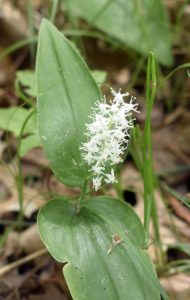Canada Mayflower
 Maianthemum canadense flowers adorn the dappled shade of the forest floor May into June. Native to Minnesota (and of course its namesake), Canada mayflower is also known as wild lily-of-the-valley. Not overly particular about whether their soil home is moist or sandy, these flowers appear near lakeshores, in bogs, and along forest trails, sending up their first leaves while the spring ephemerals are still blooming.
Maianthemum canadense flowers adorn the dappled shade of the forest floor May into June. Native to Minnesota (and of course its namesake), Canada mayflower is also known as wild lily-of-the-valley. Not overly particular about whether their soil home is moist or sandy, these flowers appear near lakeshores, in bogs, and along forest trails, sending up their first leaves while the spring ephemerals are still blooming.
In early June, the flowers start opening — about the same time as false Solomon’s seal and mountain maple tree flowers — just in time to join the full bloom of other spring wildflowers already in progress such as red columbine, wild geranium, starflower, and bluebead; trilliums are lingering, and marsh marigolds have faded. Like false Solomon’s seal, Canada mayflower is in the Ruscaceae (Butcher’s Broom) family.
Leaves are oblate-oblong to oval in shape, growing up to 3″ long and 2″ wide and are smooth along their margins (edges). The base of the leaf is heart-shaped tapering to a point at the tip with parallel veining. Not all plants flower; a single leaved plant is sterile. Fertile plants with 2 (or sometimes 3) leaves send up a stalk of tiny flowers that are about 1/4″ wide with 4 tepals of equal size (made up of 2 petals and 2 sepals), all tightly packed onto a spike-like raceme. The wide open tepals reveal the ovary and stigma, while the 4 stamens protrude every which way for a very dainty, star-like effect.
Flowers contain no nectar, but pollen attracts collecting bees along with pollen-eating flies and beetles, all aiding in cross-pollination. Soon after blooming, the petals fall off the flowers and eventually berries form in their place. Green at first, these fruits will ripen slowly through the summer into bright red in the fall, to the enjoyment of a few winged and 4-footed creatures such as ruffed grouse, white-footed mouse, and eastern chipmunk.
On a cold-weather foray into the woods someday, you may notice the bright red berries standing out delightfully against the snow-covered forest landscape, for they decoratively linger on their stems well into winter. In spring, take the opportunity to get up close to a Canada mayflower’s tiny cluster of blooms and experience breathing in their lovely scent.
